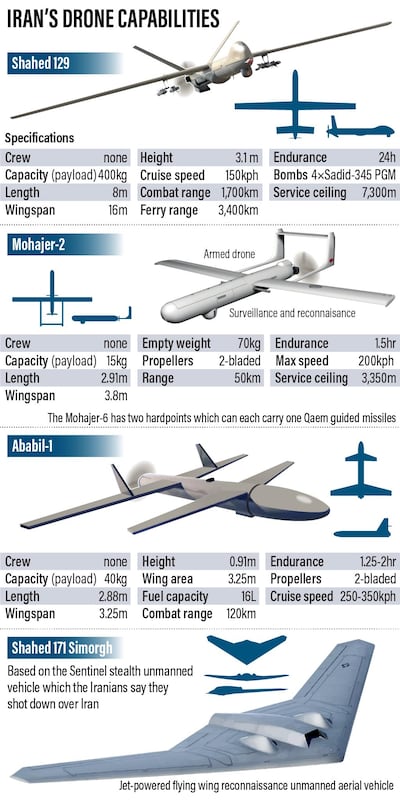In early 1991, a surprising windfall landed on Iran’s airbases. Scores of modern jets flew in from Iraq, fleeing the murderous coalition airstrikes on Saddam Hussein’s regime.
But the boon from Iran’s former nemesis was problematic because it could not get the spare parts or have the maintenance engineers to service them.
A decade later, other aircraft fell from the sky that proved much more suitable to Iran’s ambitions.
An Israeli Hermes UAV came down over the country then a few years later in 2011, an advanced CIA RQ170 Sentinel crashed over northern Iran. Both, along with other crashes, contributed to significantly to Iran’s drone programme.

Its clever scientists were able to reverse engineer the technology recovered from the wreckages for its burgeoning drone industry.
By 2016, it was accepted that Iran’s Shahed 129 – that bore an uncanny resemblance to the US Predator drones – could not only provide surveillance but also combat power. Equipped with guided munitions, the Shahed proved itself against ISIS in Syria although when it went up against US forces two were shot down by F15 jets.
The losses were troubling as the Iranians can only build about three are year, but by 2024 it is expected an armada of 40 Shahed 129s will be in flight.
They will be accompanied by more than 50 Mohajer medium-range drones that are also equipped with two precision-guided missiles, a laser range finder and advanced cameras.
Ironically, it is sanctions that forced Iran to develop its own successful drone industry mostly by reverse engineering equipment that it could buy on the open market or by other means. It has quickly found that drones are smart, relatively inexpensive and can carry out the work of hundreds of soldiers. Furthermore, it is a technology easily exported to its proxies allowing them to carry on Iran’s strategic aims with a degree of ‘plausible deniability’.
Without doubt, Iran has come a long way in producing drones that, while not the equal to US and Israeli counterparts, at least make it a serious and recognised player in unmanned warfare.
Experts recognise that Iran has achieved a level of real sophistication with its UAVs and is very proud of its success.
Through luck, espionage and clever engineering it has made an indigenous drone industry not seen elsewhere in the Middle East bar Israel.
While Saddam’s MiGs lie largely idle the thriving drone military industry is proving that manned aviation is a technology hurdle that Iran could skip.







